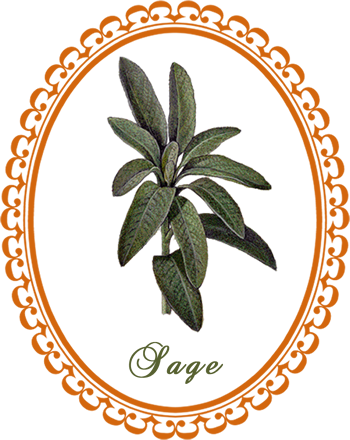
Sage: has long been considered a cure-all. The leaves provide a well-known digestive, a nerve and blood tonic, and a mouth and throat antiseptic; the aerial parts contain hormone triggers that aid the female reproductive system...
Common Names: Sage, Red Sage, garden Sage
Botanical Name: Salvia officinalis
Family: Lamiaceae
Parts Used: Leaves
Plant Type: Evergreen shrub
Flowering: July
Salvia officinalis comes from the Mediterranean region, particularly the Adriatic coast. Sage is commercially grown in the U.S., Canada, Argentina, Germany and France. Most of the world's supply is wild harvested along the Adriatic coast.
Description: Sage grows a few feet high; its woolly, gray-green oval leaves grow several inches long in opposing pairs, and give off a strong, slightly bitter, lemony scent. The square stems start to become woody in the second year. The blue, lilac, or white flowers have two lips like an open mouth and grow along shooting stems.
Cultivation: Sage is a hardy perennial sub shrub. It likes well-drained, moderately rich soil, with a pH of 6.4, in full sun to part shade.
Harvesting: Harvest the leaves just before the plant flowers (May and June)
Culinary Uses: Sage is a favorite addition to rich meats like pork, duck, and goose as its bitterness helps us to digest the fat in them and also offsets their sweet taste. No Thanksgiving turkey would be complete without sage stuffing! Sage goes well with most meats and combines especially well with thyme, onions, and parsley. Sage can be used raw, cooked or dried and used to flavor salads, soups, stews, meats and vegetables as well as oils, vinegars, and teas. Use the young leaves fresh in salads.
Sage Magick
Immortality. Longevity. Wisdom. Protection. Wishes.
Gender: Masculine
Planet: Jupiter
Element: Air
Use sage in healing and money spells.
To guard from the evil eye, wear a small horn filled with sage.
Carry sage to promote wisdom and eat some sage every day to ensure a long life.
Herbal Healing with Sage
Cosmetic Uses: Use sage infusions to color silver hair. It makes a soothing astringent aftershave and skin lotion.
Medicinal Actions: Antibacterial, antidepressant, anti-diabetic, antifungal, anti-galactagogue, anti-inflammatory, antioxidant, antirheumatic, antiseptic, antispasmodic, antisudorific, antiviral, aperitif, aperitive, astringent, blood purifier, carminative, cholagogue, cicatrizant, depurative, digestive, disinfectant (strong), diuretic, emmenagogue, estrogenic, euphoriant, expectorant, febrifuge, healing, hemostatic (bleeding gums), hepatic, hypertensor, insect repellent, laxative, nervine, stimulant (brain, circulatory system, adrenal glands), stomachic, tonic (digestive system), vermifuge, vulnerary, warming
Medicinal Uses: Drink hot infusions of sage for colds. Sage tea mixed with cider vinegar is an excellent gargle for sore throats, laryngitis, and tonsillitis. Sage tea is also an effective mouthwash for combating mouth ulcers and gum infections. It can be combined with licorice (Glycyrrhiza) to offset the bitter taste. Sage has the ability to reduce secretions of all sorts. It is a helpful herb for hot flashes and excessive sweating, night sweats, excessive salivation and will help dry up breast milk flow. Sage is useful in treating amenorrhea (the absence of menses) and painful periods. It can be taken as a tonic for fighting fatigue and nervous exhaustion, and providing immune enhancement and memory improvement. Sage is widely used in Asia to treat hemorrhoids, blood or phlegm in urine, excessive breast milk or fluid in the abdomen, insomnia and hepatitis.
Contraindications: Avoid large doses if you are pregnant, or if you have epilepsy.
Body Care with Sage
- For a sore throat, bleeding gums, loose teeth or mouth inflammations, gargle with sage leaf infusion four to six times daily, as required.
- To reduce hot flashes during menopause, or to stem lactation when weaning, take 2 or 3 size 00 capsules of powdered sage leaves up to three times daily, as necessary.
Infusion: 1 teaspoon dried or 2 teaspoons fresh sage leaves in 1 cup just-boiled water.
Source: The Essential Herbs Handbook by Lesley Bremness
If you appreciate the information provided,
please help keep this website running. Blessings!
© 2008-2025 aromaworx.ca. All rights reserved.

